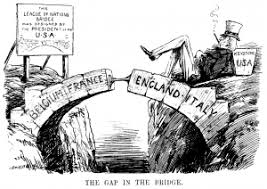
The similarities between the world situation during the interwar period (1919-1939) and today’s global environment are more important than the differences, as they emphasize repeated structural vulnerabilities that could escalate into global conflicts. In both eras, nationalism, economic volatility, and the rise of fragile international institutions laid the fertile ground for political crises. During the interwar period, the authority of the League of Nations collapsed, and the destabilizing effects of the Great Depression (1929) and authoritarian regimes emerged. The weakening of the UN’s influence in preventing large-scale wars today and the weakening of trust in multilateral agreements reflect this pattern. Recognizing these similarities is critical, as it suggests that without deliberate corrective action, modern political instability and poor crisis management can have consequences as deadly as those that lead up to World War II.
One of the defining features of the interwar period was the fragility of newly formed or weakened political institutions. The League of Nations was undermined by the absence of major powers like the United States and its inability to enforce decisions against aggressive states such as Japan during its invasion of Manchuria (1931). This failure demonstrated that international cooperation mechanisms were only as strong as their members’ willingness to act. In the present day, the United Nations Security Council faces a similar paralysis, as permanent members like Russia and China use their veto powers to block action on conflicts such as the Syrian Civil War (2011–2024). The inability of both the League then and the UN now to maintain global order illustrates how political instability at the institutional level can embolden aggressive states.
The interwar period was marked by popular disillusionment and the rapid rise of authoritarian leaders who capitalized on nationalistic fervor. Adolf Hitler’s rise to power in Germany (1933) was sparked by economic hardship and anger over the Treaty of Versailles (1919), and Benito Mussolini seized power in Italy, promising a national revival (1922). These leaders sought aggressive foreign policies that dismantled democratic institutions and destabilized regions. A similar pattern can be seen in the strengthening of the power of leaders who have reduced freedom of speech and weakened judicial independence in countries like Hungary under Viktor Orban and Russia under Vladimir Putin today. The structural mechanisms of leaders who centralize power by exploiting instability remain consistent, although the ideological content varies.
Economic chaos was a key driver of interwar instability. The hyperinflationary crisis in Weimar Germany (1921-1933) destroyed savings and encouraged extremist politics, and the Great Depression led to massive unemployment around the world. In Italy and Japan, economic discontent spread public opinion about expansionist policies as a solution to domestic problems. In our time, the 2008 global financial crisis spread mistrust in globalization and multilateral trade, contributing to political polarization in countries such as the United States and the United Kingdom (Brexit referendum, 2016). These economic shocks –whether in the 1930s or the 21st century– weakened public confidence in democratic systems and opened the door to political radicalization.
Recognizing these patterns can lead to better policy decisions today. Strengthening multilateral institutions, implementing consistent deterrence, and addressing economic inequality are important steps to avoid repeating mistakes during war. Historical precedent suggests that neglect of these measures increases instability and increases the cost of intervention exponentially. Preemptive investment in diplomacy and crisis prevention is much cheaper than
reactive warfare. These lessons are applicable today, just as in the 1930s, when missed opportunities for early action eventually led to catastrophe.
The interwar period is not the perfect mirror of the present, but its lessons are still urgent. Political instability, economic turmoil, and weak crisis management are timeless factors in conflicts on a global scale. Modern society has unique characteristics, but it does not guarantee immunity from war. The similarities between the two periods serve as a warning that, without boundaries and meaningful reforms, history may once again rhyme with the past. Understanding and acting on these similarities are therefore more important than consolation for differences.
Works Cited
Are we in the interwar period? – oped – Eurasia Review. (n.d.-a). https://www.eurasiareview.com/29032025-are-we-in-the-interwar-period-oped/
How an international order died: Lessons from the interwar era. War on the Rocks. (2024, June 12). https://warontherocks.com/2021/08/how-an-international-order-died-lessons-from-the-interwar-era-2/
The real lessons of the interwar years. Journal of Democracy. (n.d.). https://www.journalofdemocracy.org/articles/the-real-lessons-of-the-interwar-years/
By. Jungwoo Choe

